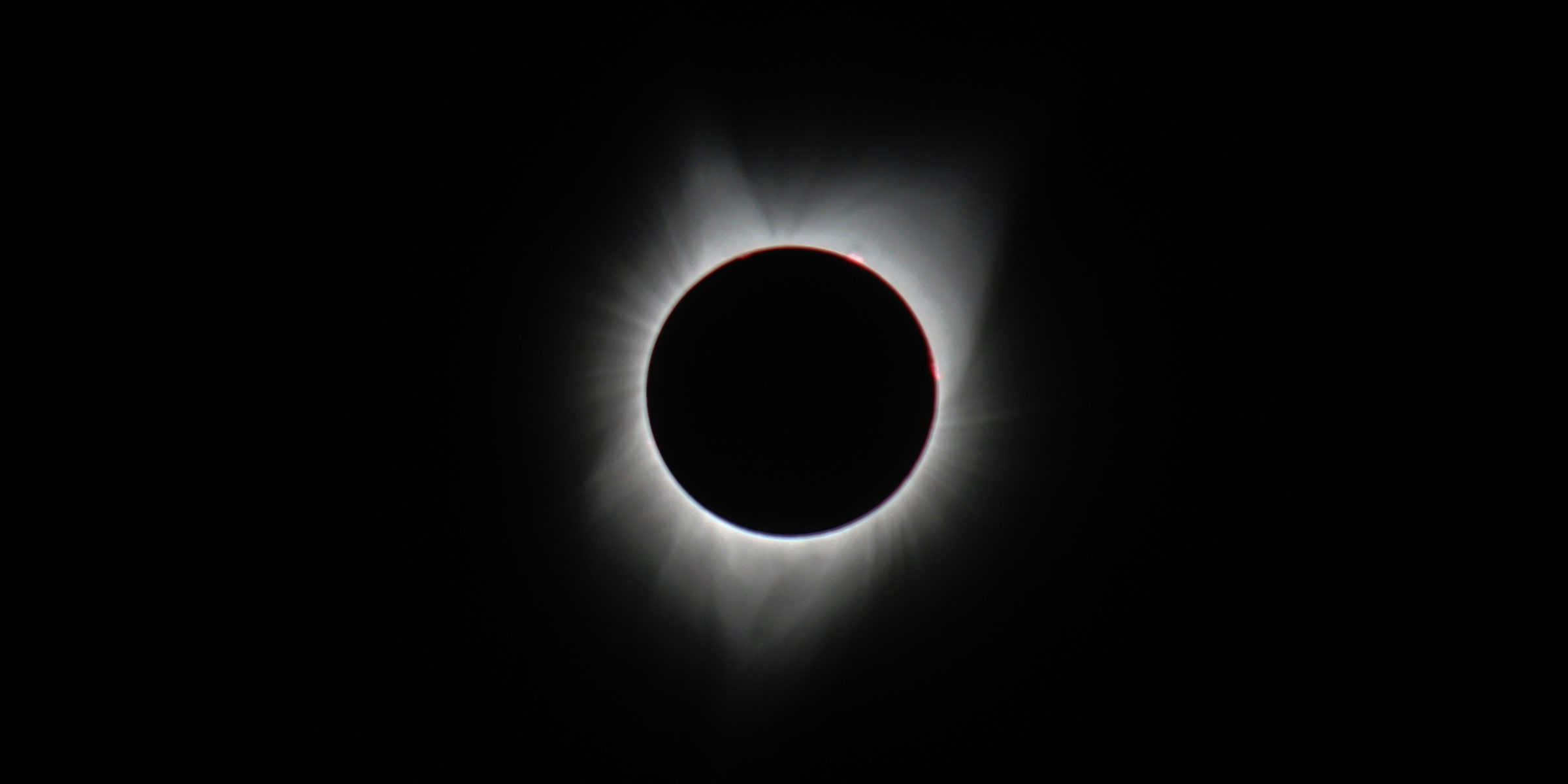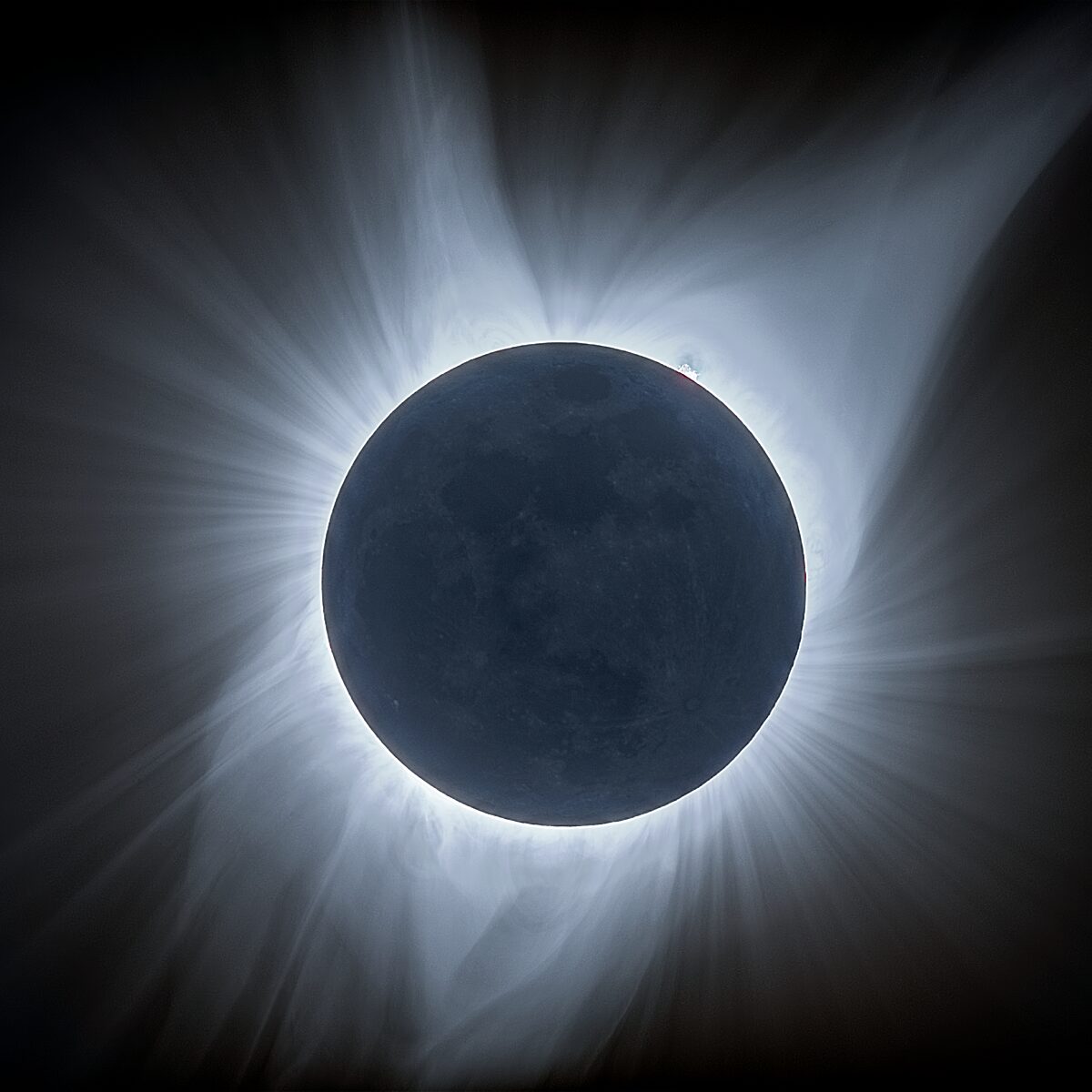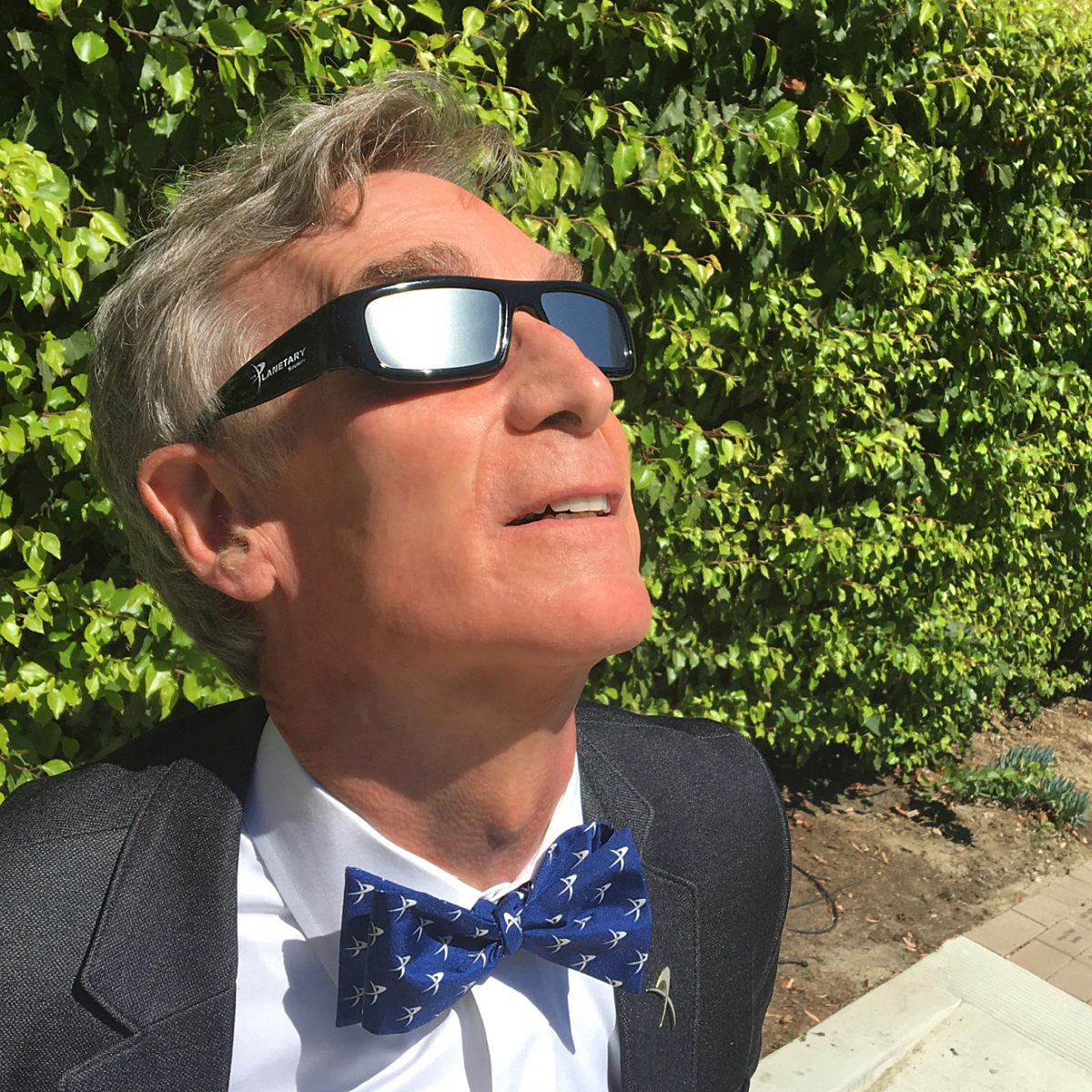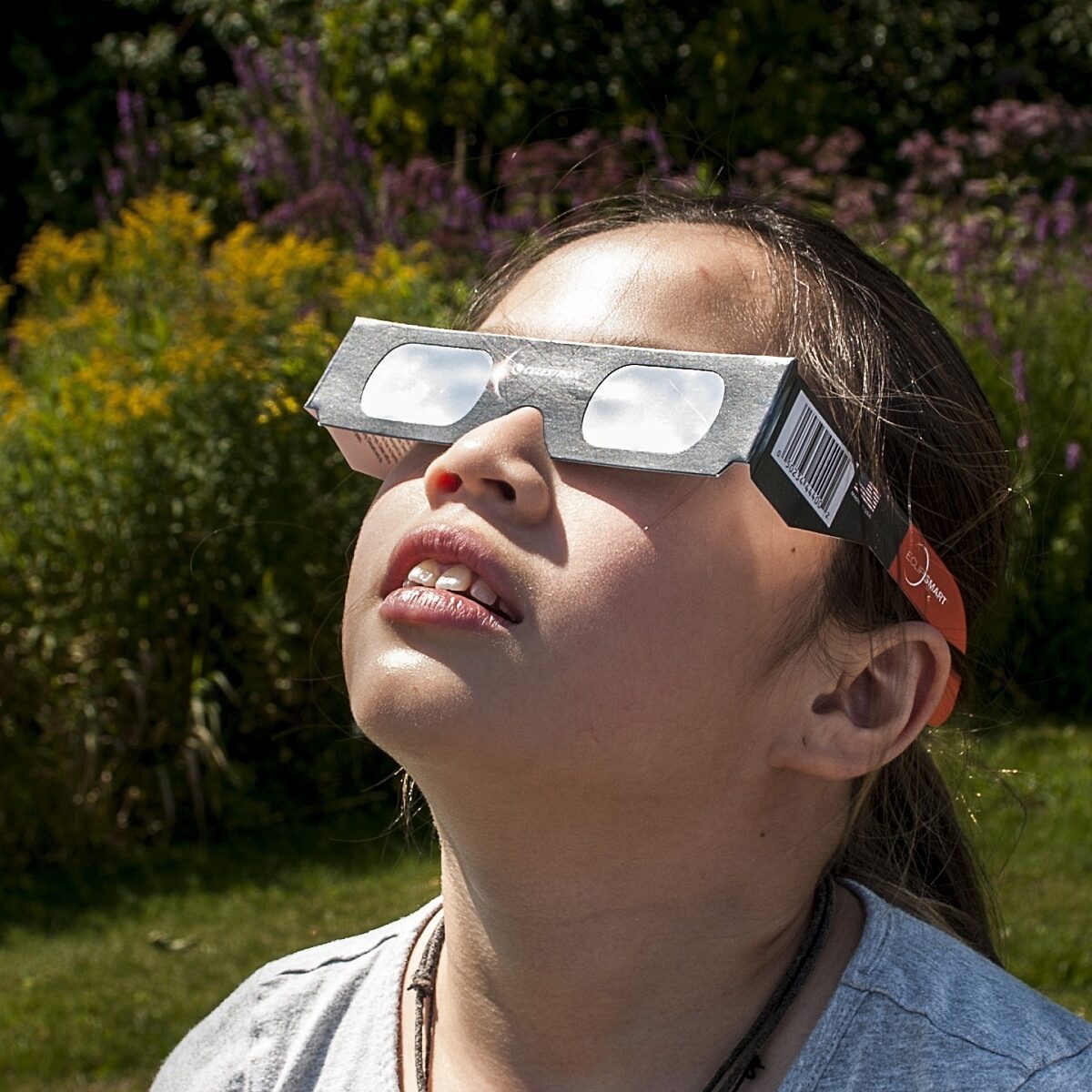Bruce Betts • Jul 13, 2020
What Is a solar eclipse? Your questions answered.
Save the Date: see a total solar eclipse with The Planetary Society!
A total solar eclipse will dazzle spectators living in North America on April 8, 2024. The Planetary Society will be offering an unforgettable viewing experience from the Texas hill country.
It will be two decades until the next opportunity to view a total solar eclipse in the U.S., so save the date and start making your plans to join us! Make sure you're signed up to receive updates from us at planetary.org/connect.
What is an eclipse?
An eclipse occurs when one celestial body passes in front of a second celestial body as seen from a third celestial body—in other words, an eclipse occurs when three bodies line up. The fun-to-say scientific term for this is “syzygy,” and it doesn’t strictly mean the Earth, Moon and Sun. One example: NASA’s Curiosity rover has captured images of Mars’ moon Phobos crossing in front of the Sun!
What is a solar eclipse?
As seen from the Earth, a solar eclipse occurs when the Moon passes in front of the Sun.
Solar eclipses explained An eclipse is a celestial event that happens when a planet, a moon, and a star line up in a specific way. When the Moon is in the middle of the lineup, you get a solar eclipse. As the Moon blocks the light of the Sun, a giant Moon shadow covers parts of the Earth, resulting in some astonishing visual experiences.
What is a total solar eclipse?
In a total solar eclipse the Moon completely blocks out the Sun, and viewers are completely in the Moon's shadow. While the Sun is blocked out, its wispy outer atmosphere, known as the corona, becomes visible.
How big an area on Earth is covered by a total solar eclipse?
A total solar eclipse is only visible from a limited area: the line traced by the Moon’s shadow, known as the path or totality, as it moves across the Earth. Typically this line is just a few tens of kilometers wide, so most people must travel to see a total solar eclipse. A much broader area surrounding the path of totality sees a partial solar eclipse.
What will you see during a total solar eclipse?
Just before the Moon completely covers the Sun, there is a moment referred to as the diamond ring, when the last rays of the Sun peek past one side of the Moon. Next you may see a sight known as Baily’s Beads, where bits of sunlight stream between mountains and canyons at the Moon's edge.
But what about totality itself? Sounding like the trailer to a horror movie, but much more impressive and considerably less dangerous: day will turn into night, birds may stop singing, sunset will appear all around you, stars and planets will become visible in the darkened sky, and the otherwise hidden solar corona will become visible as white rays streaming out from around the dark lunar disk. A total solar eclipse is truly one of nature’s most amazing sights. As you get swept away, don’t forget that once the sunlight starts appearing from around the Moon, you need eye protection to keep watching.
There is a huge difference between being in the path of totality, where the Moon blocks 100% of the Sun, versus a nearby location where the Moon blocks even 99% of the Sun. That little bit of sunlight will wipe out the more profound effects of totality.

Your guide to future total solar eclipses
Bruce Betts and Sarah Al-Ahmed provided a guide to all total solar eclipses through the end of the 2020s, with dates and locations.
What is a partial solar eclipse?
A partial solar eclipse occurs when the Moon covers only a portion of the Sun. Some solar eclipses are only partial. During a total solar eclipse, areas surrounding the path of totality see a partial eclipse, and even those directly in the path see a partial eclipse as the Moon gradually covers and then moves off of the Sun.

What will you see during a partial solar eclipse?
As the Moon gradually crosses in front of the Sun, it will look like larger and larger bites are being taken out of it. Then, the Moon will begin to move off of the Sun's disk. The farther you are from the path of totality or annularity, the smaller the amount of the Sun that will be blocked out at the maximum point.
As the Moon slowly moves across the Sun over two to three hours, don’t forget to take a little time to ponder that you’re seeing the effect of the Moon 400,000 kilometers away passing in front of the gigantic Sun 150 million kilometers away.
Why don’t we have a solar eclipse every New Moon, when the Moon is between the Sun and Earth?
There isn’t a solar eclipse every New Moon because the Moon’s orbit is tilted five degrees compared to Earth’s. Thus, the Moon only can cause an eclipse when its orbital plane intersects with Earth’s. This occurs twice a year.

What is an annular solar eclipse? What’s the difference between an annular solar eclipse and total solar eclipse?
Both the Moon’s orbit and the Earth’s orbit are somewhat elliptical—in other words, noncircular. Thus, the distances between the Earth, the Moon, and the Sun vary from eclipse to eclipse. This makes the apparent sizes of the Moon and Sun as seen from Earth vary from eclipse to eclipse. A total eclipse occurs when the Moon appears at least as large as the Sun. An annular eclipse occurs when the Moon appears slightly smaller than the Sun, and cannot cover the Sun completely.
What does an annular eclipse look like? What is the “ring of fire”?
During an annular eclipse, there comes a moment when the Moon is centered in front of the Sun but does not cover the Sun. This leaves an annulus, or circle, of Sun still visible on the outside of the Moon. This is sometimes called the “ring of fire.”
How long do annular eclipses last?
The time that the eclipse is truly annular, like the time of totality during a total solar eclipse, is short: just a few minutes. Partial eclipses before and afterwards will last as much as two or three hours.

What is a hybrid solar eclipse?
During a hybrid solar eclipse, some locations on Earth see a total eclipse, while others that are farther away from the Moon because of Earth's roundness see an annular eclipse.
How many solar eclipses are there each year?
There are at least two solar eclipses of one kind or another (total, annular, or partial) each year. However, because the area affected is limited, particularly for total eclipses, people often travel great distances to witness them. Sometimes that means traveling by boat out into the ocean, or flying in a plane above the clouds!

Is it dangerous to look at a solar eclipse?
Without proper protection, yes. Looking directly at the Sun with your naked eyes can cause permanent eye damage. The exception is the brief, two-minute period of complete totality during a total solar eclipse, when the Moon is completely blocking the Sun except for the corona. Looking at the Sun without protection during an annular or partial eclipse can still cause eye damage.
Sunglasses are not sufficient to protect your eyes from looking directly at the Sun. Instead, use specialized eclipse glasses, which you can order ahead of time. They range from simple cardboard frames to sturdier versions. Another option is welder's glasses, but only if they are #14 or darker.
It is very dangerous to look at the Sun through unfiltered telescopes, binoculars, cameras, and other optical device. Filters are available that can make viewing the Sun through optical devices safe, providing they are used properly.
Are your solar eclipse glasses safe?
A guide to how to make sure your solar eclipse glasses are safe and certified, plus tips on what to do — and what not to do — if you want to experience an eclipse without glasses.
One fun way to view eclipses that is well-suited to children is projecting images of the Sun using simple pinhole or equivalent devices. You can put a small hole in a piece of cardboard and project an image of the Sun onto a sidewalk or a piece of paper. Or, simply place one hand on top of the other with your fingers partially spread out to form a waffle pattern. In both cases, the images of the sun you project will be bright circles with dark “bites” taken out of them.
How to Make a Pinhole Projector Want to see an eclipse without wearing solar glasses? Try this easy trick to make a pinhole projector.
Sharing an eclipse with kids
Here's a simple and safe way to observe solar eclipses that's appropriate for young children, with no eclipse glasses or other special equipment needed.
How have solar eclipses been used in science?
Solar eclipses have enabled scientific studies and discoveries since at least the mid-19th century. During a total solar eclipse, the Sun’s upper atmosphere, known as the corona, becomes visible. Eclipses enabled the first study of the corona, which is normally not visible because it is overshadowed by the brightness of the photosphere, the upper “surface” of the Sun that we see light emanating from.
Amazingly, the first evidence of the element helium came from observations made during an 1868 total solar eclipse. Spectra, created by the breaking up of the Sun’s light into its wavelength components, indicated an unknown element, which was eventually determined to be helium. Because of the method of discovery, it is named after the Greek word for Sun which is helios.
A 1919 solar eclipse was used to test Einstein’s theory of general relativity. By taking pictures of stars during the eclipse, scientists were able to show that their light was indeed bent by the gravity of the Sun as predicted by Einstein.
How have solar eclipses been interpreted in history?
In history, eclipses have been taken as everything from portents of doom to portents of peace. Some ancient empires believed them to be signs of bad fortune for their rulers. Others interpreted them differently. The ancient Greek historian Herodotus wrote that an eclipse that occurred during a battle between the Medes and the Lydians caused both sides to put down their weapons and declare peace.
Eclipses have also been used by modern historians to help with chronologies of ancient civilizations, for example, a solar eclipse recorded in an Assyrian text was correlated with a solar eclipse that would’ve occurred in 763 BC. Chinese records of eclipses begin at a similar time, and indicate their ability to predict eclipses.
Support our core enterprises
Your support powers our mission to explore worlds, find life, and defend Earth. You make all the difference when you make a gift. Give today!
Donate

 Explore Worlds
Explore Worlds Find Life
Find Life Defend Earth
Defend Earth





